可视化图形有哪些?
比较
比较数据间各类别的关系,比如折线图
联系
查看多个变量之间的关系,比如散点图
构成
数据占整体的比重,比如饼图
分布
变量的分布情况,比如直方图
种类介绍
散点图
我们使用matplotlib包这里,先导入
import matplotlib.pyplot as plt
散点图适用于观察变量之间的关系
散点图语句:
plt.scatter(x, y, marker=None)
x,y是坐标,marker代表了图形中标记的符号形状,有三种:‘x’,‘>’,‘o’。
当然,也可以使用Saborn进行散点图的绘制。
导包路径:
import seaborn as sns
语句:
sns.jointplot(x, y, data=None,kind=‘scatter’)
其中x,y是data中的下标,data是我们要传入的数据,一般是DataFrame类型。kind这类我们取值scatter代表散点的意思。不同的kind能绘制出不同的图形。
我们随机1000个点来画图
例子:
import numpy as np
import pandas as pd
import matplotlib.pyplot as plt
import seaborn as sns
# 数据准备
N = 1000
x = np.random.randn(N)
y = np.random.randn(N)
# 用 Matplotlib 画散点图
plt.scatter(x, y,marker='x')
plt.show()
# 用 Seaborn 画散点图
df = pd.DataFrame({'x': x, 'y': y})
sns.jointplot(x="x", y="y", data=df, kind='scatter');
plt.show()
结果(摘自极客时间):
matplotlib:

Seaborn:

折线图
matplotlib语句:
plt.plot()
我们需要将数据按照x轴的大小进行排序,要不然画出来的折线就无法按照x轴递增的顺序展示。
Seaborn语句:
sns.lineplot (x, y, data=None)
其中x,y是data中的下标,data是我们要传入的数据,一般是DataFrame类型。
例子(摘自极客时间):
设置x,y的数组,x代表时间(年),y数组我们随便取值。
import pandas as pd
import matplotlib.pyplot as plt
import seaborn as sns
# 数据准备
x = [2010, 2011, 2012, 2013, 2014, 2015, 2016, 2017, 2018, 2019]
y = [5, 3, 6, 20, 17, 16, 19, 30, 32, 35]
# 使用 Matplotlib 画折线图
plt.plot(x, y)
plt.show()
# 使用 Seaborn 画折线图
df = pd.DataFrame({'x': x, 'y': y})
sns.lineplot(x="x", y="y", data=df)
plt.show()
matplotlib:

Seaborn:
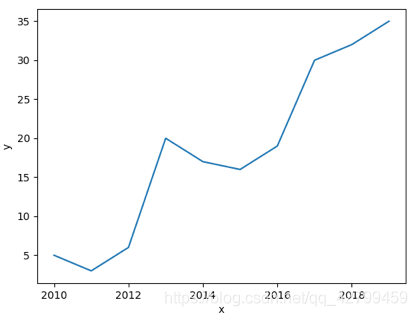
可以看到seaborn只是多标记了x,y轴含义
直方图
matplotlib语句:
plt.hist(x,bins=10)
x是一维数组,bins代表直方图中矩形条的数量,默认是10
Seaborn语句:
sns.distplot(x,bins=10,kde=True)
x是一维数组,bins代表直方图中矩形条的数量,kde代表显示核密度估计,默认是True。核密度估计是通过核函数帮助我们来估计概率密度的方法。
例子:
import numpy as np
import pandas as pd
import matplotlib.pyplot as plt
import seaborn as sns
# 数据准备
a = np.random.randn(100)
s = pd.Series(a)
# 用 Matplotlib 画直方图
plt.hist(s)
plt.show()
# 用 Seaborn 画直方图
sns.distplot(s, kde=False)
plt.show()
sns.distplot(s, kde=True)
plt.show()
matplotlib:
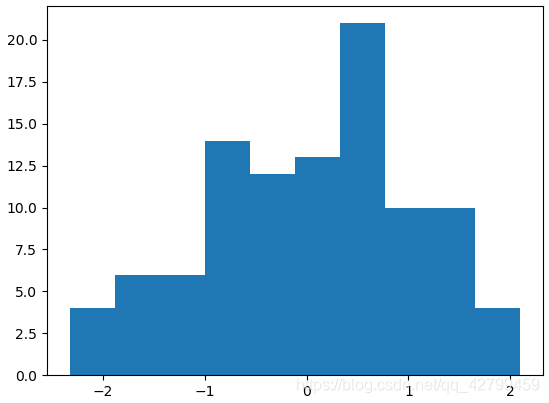
seaborn:
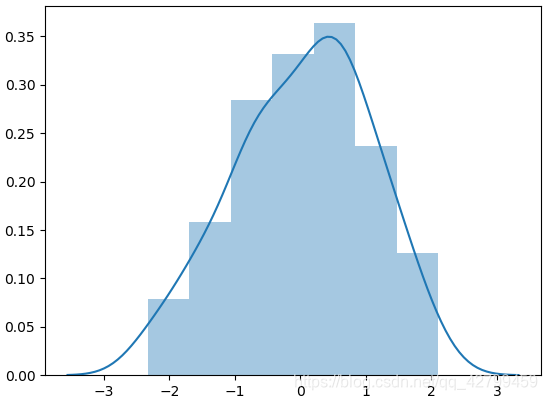
条形图
matplotlib语句:
plt.bar(x,height)
x代表x轴的位置序列,height是y轴的数值序列,也就是柱子的高度。
seaborn语句:
sns,barplot(x=None,y=None,data=None)
data是DataFrame类型,x,y是data中的变量
例子:
import matplotlib.pyplot as plt
import seaborn as sns
# 数据准备
x = ['Cat1', 'Cat2', 'Cat3', 'Cat4', 'Cat5']
y = [5, 4, 8, 12, 7]
# 用 Matplotlib 画条形图
plt.bar(x, y)
plt.show()
# 用 Seaborn 画条形图
sns.barplot(x, y)
plt.show()
matplotlib:

seaborn:
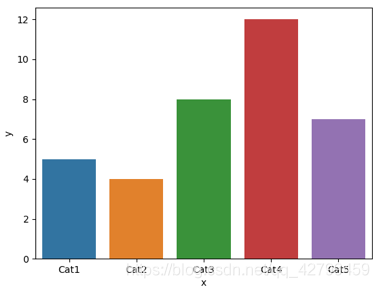
箱线图
箱线图,又称盒式图。由五个数值点组成:最大值、最小值、中位数、和上下四分位数。箱线图能够帮助我们分析出数据的差异性、离散程度和异常值等。
matplotlib语句:
plt.boxplot(x, labels=None)
x代表要绘制箱线图的数据,labels是缺省值,可以为箱线图添加标签。
seaborn语句:
sns.boxplot(x=None,y=None,data=None)
data为DataFrame类型,x,y是data中的变量
例子:
# 数据准备
# 生成 0-1 之间的 10*4 维度数据
data=np.random.normal(size=(10,4))
lables = ['A','B','C','D']
# 用 Matplotlib 画箱线图
plt.boxplot(data,labels=lables)
plt.show()
# 用 Seaborn 画箱线图
df = pd.DataFrame(data, columns=lables)
sns.boxplot(data=df)
plt.show()
matplotlib:

seaborn:
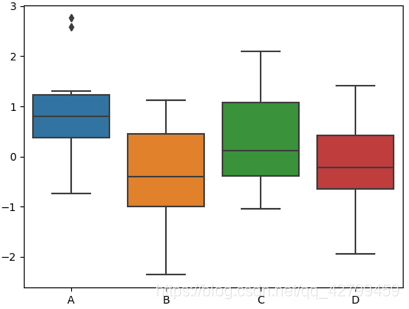
饼图
matplotlib语句:
plt.pie(x,labels=None)
x代表要绘制饼图的数据,lables是缺省值,可以为饼图添加标签。
例子:
import matplotlib.pyplot as plt
# 数据准备
nums = [25, 37, 33, 37, 6]
labels = ['High-school','Bachelor','Master','Ph.d', 'Others']
# 用 Matplotlib 画饼图
plt.pie(x = nums, labels=labels)
plt.show()
结果:









 本文深入介绍了数据可视化的五种核心方法:折线图用于比较数据趋势;散点图揭示变量间的关系;饼图展示数据占比;直方图呈现数据分布;箱线图分析数据差异性和异常值。并提供了matplotlib和seaborn两种常用绘图库的使用示例。
本文深入介绍了数据可视化的五种核心方法:折线图用于比较数据趋势;散点图揭示变量间的关系;饼图展示数据占比;直方图呈现数据分布;箱线图分析数据差异性和异常值。并提供了matplotlib和seaborn两种常用绘图库的使用示例。
















 5580
5580

 被折叠的 条评论
为什么被折叠?
被折叠的 条评论
为什么被折叠?








